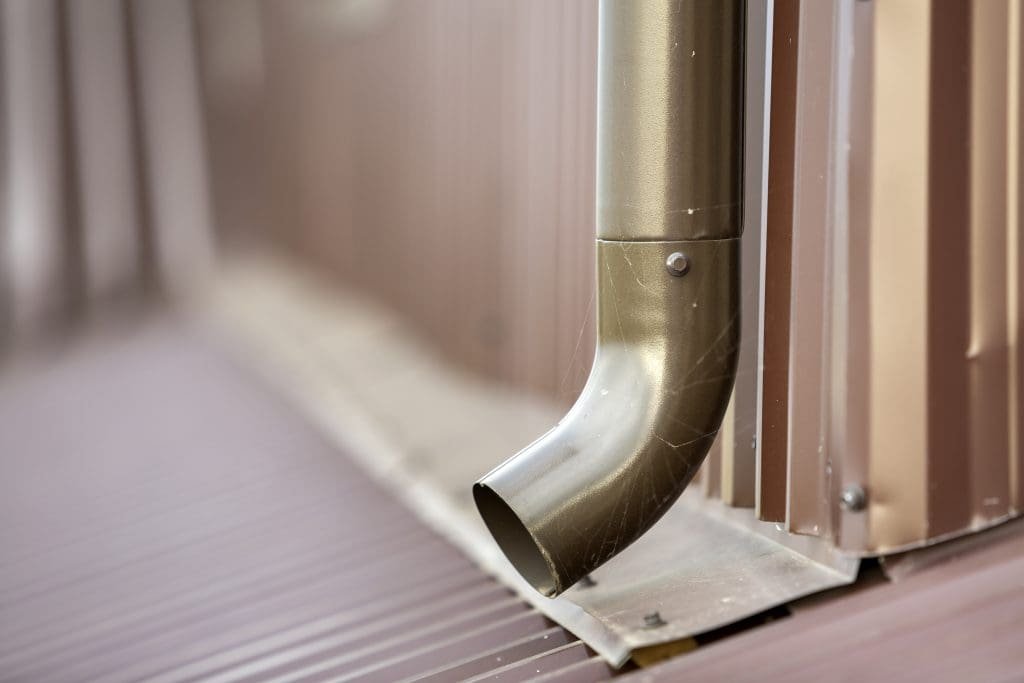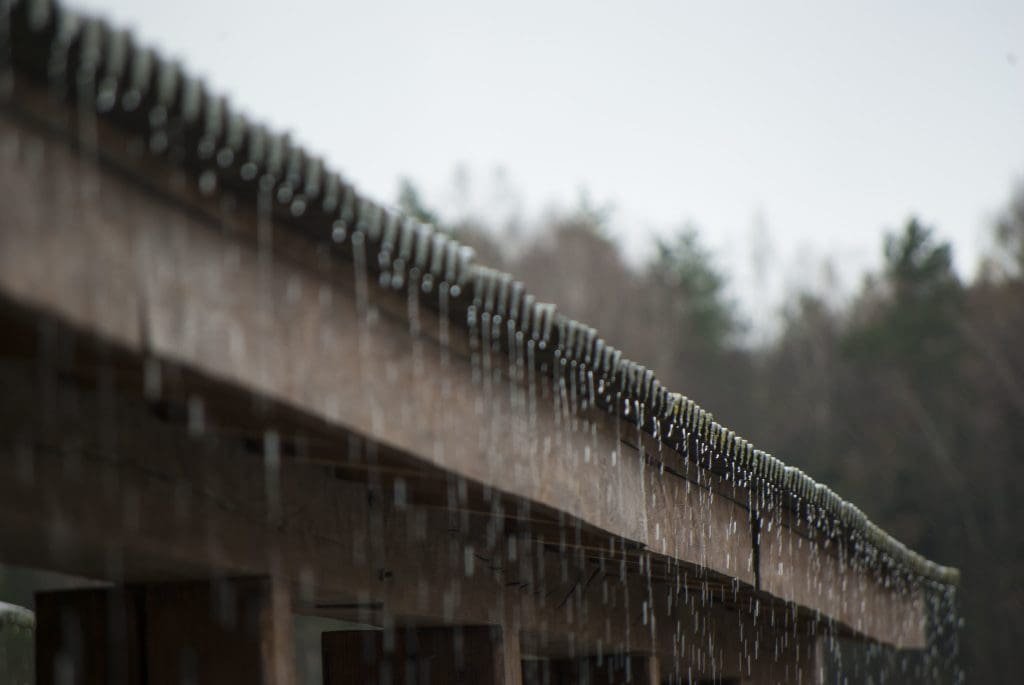Summer storms can have a significant impact on various aspects of our homes, and one area that often bears the brunt of these weather events is our gutters. Gutters play a crucial role in maintaining the integrity and functionality of our homes, so it is essential to understand how summer storms can affect them. In this article, we will explore the role of gutters in home maintenance, the impact of summer storms on gutters, how to identify gutter damage after a storm, and preventative measures for protecting your gutters. We will also discuss the importance of repairing and replacing damaged gutters and how to choose the right professional for gutter-related issues.
Understanding the Role of Gutters in Home Maintenance
Gutters serve as a crucial component of our homes’ drainage system. Their primary function is to collect water that falls on the roof and direct it away from the house’s foundation. By doing so, gutters help prevent water damage, erosion, and flooding, which can cause significant structural issues.
The Basic Function of Gutters
When rainwater or melted snow flows down the roof, gutters catch it and channel it through downspouts to a designated drainage area, preventing it from pooling around the foundation. This helps protect your home’s foundation from excessive water exposure, which can lead to cracks, shifting, and other severe problems.
Besides safeguarding the foundation, gutters also prevent water from pouring directly off the roof onto exterior walls, doors, and windows. This reduces the likelihood of water seeping into the house and causing interior damage, such as mold growth, rotting of wooden structures, and water stains.
Importance of Regular Gutter Maintenance
To ensure that gutters function properly, regular maintenance is essential. Over time, gutters can accumulate debris like leaves, twigs, and dirt, which obstruct the flow of water. When clogs occur, water overflows, which can damage the roof, fascia boards, and even the gutters themselves. Regular gutter cleaning and inspection help prevent clogs and ensure optimal functionality.
Additionally, gutter maintenance involves checking for signs of wear and tear, rust, and loose joints. Addressing these issues promptly can prevent them from escalating into more severe problems and extend the lifespan of your gutters.
Furthermore, it is important to note that gutters come in various materials, including aluminum, copper, vinyl, and steel. Each material has its own advantages and disadvantages, so it’s crucial to choose the right one for your home. For example, aluminum gutters are lightweight, affordable, and resistant to rust, making them a popular choice among homeowners. On the other hand, copper gutters are known for their durability and aesthetic appeal, but they come with a higher price tag.
When it comes to gutter installation, it’s best to hire a professional to ensure proper placement and alignment. Improperly installed gutters can lead to water leakage, sagging, and other issues. A professional installer will also be able to recommend the appropriate gutter size and style for your home, taking into consideration factors such as roof pitch, average rainfall, and the surrounding landscape.
The Impact of Summer Storms on Gutters

Summer storms are often accompanied by heavy rainfall and strong winds, which can take a toll on gutters. Understanding the potential effects of these weather events will help homeowners be proactive in protecting their gutter systems.
When it comes to heavy rainfall, gutters play a crucial role in directing water away from the foundation of your home. However, during intense summer rainstorms, the volume of water flowing off the roof increases significantly. If gutters are clogged or not properly maintained, they may struggle to handle this excess water. Overloaded gutters can sag, detach from the house, or even collapse under the weight. In extreme cases, water may spill over the sides and seep into the walls and foundation, causing extensive damage.
Effects of Heavy Rainfall on Gutter Performance
During intense summer rainstorms, the volume of water flowing off the roof increases significantly. If gutters are clogged or not properly maintained, they may struggle to handle this excess water. Overloaded gutters can sag, detach from the house, or even collapse under the weight. In extreme cases, water may spill over the sides and seep into the walls and foundation, causing extensive damage.
It’s essential for homeowners to regularly clean and inspect their gutters to ensure proper functioning, especially before the stormy season hits. Installing gutter guards can also help prevent debris buildup and clogging, maintaining the efficiency of your gutter system even during heavy downpours.
Wind Damage and Your Gutters
Summer storms are often accompanied by strong winds that can wreak havoc on gutters. High winds can loosen gutter brackets, break connections, or cause gutter sections to disconnect completely. When this happens, gutters become ineffective in redirecting water away from your home, leaving it vulnerable to water damage.
Furthermore, heavy gusts of wind can blow debris, tree branches, and other objects onto your roof, causing damage to gutters. It is crucial to inspect your gutters for any signs of dents, bends, or other structural damage after a storm. Prompt repairs can prevent further deterioration and ensure the continued functionality of your gutters.
Ensuring that your gutters are securely fastened to your home and free of any blockages is essential in protecting your property from the damaging effects of summer storms. By staying proactive and addressing any issues promptly, homeowners can safeguard their gutters and maintain the integrity of their homes during inclement weather conditions.
Identifying Gutter Damage After a Storm

After a summer storm, it is essential to inspect your gutters for signs of damage. Detecting and addressing issues early can prevent them from escalating into more extensive and costly problems.
Summer storms can wreak havoc on your home’s gutter system, potentially leading to water damage and structural issues if left unchecked. Taking the time to assess the condition of your gutters post-storm is a proactive measure that can save you time and money in the long run.
Signs of Gutter Blockage
One of the most common issues after a heavy storm is gutter blockage. Blockages can occur due to the accumulation of debris, especially if gutters have not been regularly cleaned. Signs of blockage include overflowing water, pools of water around the foundation, or water trickling down the exterior walls. If you notice any of these signs, it is crucial to remove the blockage promptly to prevent further damage.
Furthermore, clogged gutters can attract pests and insects, creating an additional issue for homeowners. Mosquitoes, ants, and even rodents are drawn to stagnant water, increasing the risk of infestations near your home.
Detecting Structural Damage to Gutters
Inspect your gutters for any visible signs of damage after a storm. Look for dents, cracks, disconnected sections, or loose brackets. Pay attention to leaks or dripping water from joints or seams. If you identify any of these issues, it is advisable to have a professional assess the extent of the damage and recommend appropriate repairs or replacements.
Ignoring structural damage to your gutters can lead to water seepage into your home’s foundation, causing cracks and compromising its stability. Additionally, damaged gutters can result in water pooling around your property, potentially leading to erosion and landscape damage over time.
Preventative Measures for Protecting Your Gutters

Prevention is key when it comes to maintaining the longevity and functionality of your gutters. Taking proactive measures ensures that your gutters can withstand summer storms and continue to protect your home effectively.
Proper gutter maintenance not only safeguards your home’s foundation and landscaping but also contributes to the overall aesthetics of your property. Well-maintained gutters can enhance the curb appeal of your home, giving it a polished and well-cared-for appearance that can increase its value.
Regular Gutter Cleaning
Regular gutter cleaning is essential to prevent blockages and ensure optimal gutter performance. Clean your gutters at least twice a year, preferably in spring and fall, to remove debris and allow water to flow freely. If you have overhanging trees near your house, consider cleaning your gutters more frequently to prevent excessive buildup.
During your gutter cleaning routine, it’s also a good idea to inspect the condition of your gutters for any signs of damage or wear. Look for rust, corrosion, loose fasteners, or sagging sections, as addressing these issues promptly can prevent more significant problems down the line and extend the lifespan of your gutter system.
Installing Gutter Guards
Gutter guards are an excellent addition to your gutter system, especially if you live in an area with a high risk of debris accumulation. These devices cover the gutters, preventing leaves, twigs, and other debris from entering. Gutter guards reduce the frequency of gutter cleaning and minimize the chance of blockages during summer storms.
When selecting gutter guards for your home, consider the design and material that best suits your needs. From mesh screens to bottle brush inserts, there are various types of gutter guards available, each offering unique benefits in terms of durability and effectiveness. Investing in high-quality gutter guards can provide long-term protection for your gutters and save you time and effort in maintenance tasks.
Repairing and Replacing Damaged Gutters

When damage occurs to your gutters, it is essential to address it promptly to prevent further deterioration and potential harm to your home’s foundation and structure. Knowing when to repair or replace your gutters is crucial in making informed decisions.
When to Repair vs. Replace Your Gutters
If the damage to your gutters is minimal and confined to a specific section, repairs may be sufficient. This includes fixing loose brackets, sealing leaks, or replacing a small damaged section of the gutter. However, if the damage is extensive, widespread, or if your gutters have reached the end of their lifespan, it may be more cost-effective to replace the entire gutter system.
Choosing the Right Professional for Gutter Repair and Replacement
When it comes to gutter repair and replacement, it is essential to hire a qualified professional with experience in working with gutters. Look for reputable companies or contractors who specialize in gutter services. Check their credentials, read customer reviews, and request quotes from multiple providers to ensure you make an informed decision.
Additionally, it is important to consider the materials used in gutter repair or replacement. Traditional gutters are commonly made of aluminum, which is lightweight, durable, and resistant to rust. However, there are also options available in materials such as copper, which offers a more elegant and distinctive look but comes at a higher cost. Understanding the pros and cons of different gutter materials can help you make the right choice for your home.
Furthermore, it is worth noting that gutter systems can be customized to suit your specific needs. For example, if you live in an area with heavy rainfall, you may want to consider installing larger downspouts or gutter guards to prevent clogs and overflow. Discussing your requirements with a professional can help you determine the best gutter system design for your home.
In conclusion, summer storms can have a significant impact on the functionality and effectiveness of your home’s gutters. Understanding the role of gutters, the impact of summer storms, and how to identify and address gutter damage is crucial for homeowners. By implementing regular maintenance practices, taking preventative measures, and addressing gutter issues promptly with professional help, you can ensure the longevity and proper functioning of your gutters, ultimately protecting your home from potential water damage caused by summer storms.





